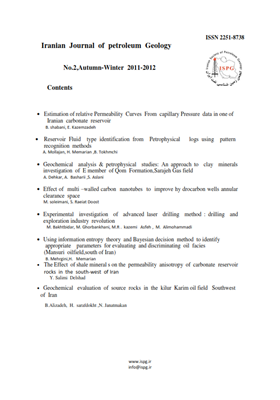The effect of shale minerals on the permeability anisotropy of carbonate reservoir rocks in the south-west of Iran
Subject Areas :
Keywords: : Permeability anisotropy mean hydraulic radius core gamma kaolinite chlorite montmorillonite ,
Abstract :
The vertical permeability of reservoir rocks is of paramount importance in production strategies, EOR studies and reservoir management. The carbonate reservoirs are inherently heterogeneous and vertical permeability is different from horizontal permeability. This permeability anisotropy depends on deposition history and diagenesis, type and amount of shale present in the formation and compressibility of the rock. In this study the effect of clay minerals has been investigated on the permeability anisotropy of Dalan formation in one of the South-West reservoirs of Iran using core Gamma log. For this purpose 233 core plug samples from 3 wells were selected and their petrophysical properties were measured. Natural gamma of the samples, including thorium and Potassium, was also measured by a core gamma logger and the samples were separated into 3 groups reach in Chlorite, Kaolinite and Montmorillonite clay minerals. Then vertical permeability of each group of shale-type was plotted against the mean hydraulic radius of horizontal samples and empirical equations of their permeability anisotropy were obtained. There was a good match between predicted and measured vertical permeability of some core plugs from another well in the reservoir. The studies indicated that permeability anisotropy is gradually increased with increasing porosity and the core samples containing Kaolinite have the most permeability anisotropy and the ones containing Montmorillonite have the least anisotropy.

